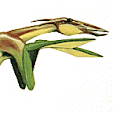Here it is again. I received some questions where it right front fin had gone. Was it amputated or had I forgotten it? No, I replied, I worked out the perspective and the missing fin is simply hidden by the body. I admit that I saw these people's point and have been tempted to tweak the perspective a bit and have the tip of the 'missing' fin emerge from behind the body. Its absence seems to be disturbing in a way. While working on Fish and Cloakfish I experimented a bit with the reasons.
This image shows two versions of a ray-like species of Fishes IV. The top image shows a layer for the perspective lines as well as a layer containing some rough idea of light and colour. Layers, for those of you not familiar with computer painting programs, are the computer equivalent of a pane of glass on which you paint. The painting as a whole can consist of many such panes, each consisting a different bit of the painting. The trick is that you can make layers invisible, change their transparency or swap their order. I use Painter 11 as I like its tools, that resemble artists' brushes more than the tools of Photoshop CS5. As you can see from the sketch the perspective effect is fairly strong, meaning that parallel lines diverge quite a bit. Still, the drawing seems to work, perhaps because all parts of the animal are visible.

Apart from 'regular' Fishes, I have been working on Cloakfish, completely unrelated to Fishes I to VI. You will find cloakfish on the main Furaha page, but also here on the blog. Apart from a few sketches almost all my earlier work on cloakfishes involved computer graphics, because I wished to see their four 'cloaks' move while swimming. At present it is time to paint them, but I wished to get their cloaks right, and doing that by hand would be very difficult. So I took recourse to computer graphics, a process best described as 'practical' ('cheating' comes to mind, but why not use tools when available?). To help the process, I adapted earlier programmes in Matlab so I could produce a cloak with any shape I wished, as on the left, that is warped to produce waves progressing along it, as on the right. Right; make four of them, export them as 3D files, import them in a suitable 3D program (Vue Infinite in my case, and we are ready to play.
Here is an example. The left panel shows the four cloaks, striped to help visualise their 3D shape, attached to a central axis (that is called a 'dagger', by the way). The body proper is formed by some basic shapes such as cylinders and rectangles. I thought it might be worthwhile to put lots of parallel rods in the image that could help get a better feel for the perspective. I set the focal distance of the imaginary camera in Vue to 35 mm, and that is the image in the left-hand panel. The perspective looks believable, does it not?
The right-hand side was produced in Painter 11. I imported the image from Vue and painted a rough cloakfish on a semitransparent layer above it. I decided to play around with the front edge of the funnel. In that stage of their evolution, cloakfish were all filter feeders, so the opening in the front doubles as a food and a respiratory intake. Some cloakfish evolved feelers, and those are what you see here. I wasn't happy with the sketch though, and wondered whether the perspective was part of the problem.
So I went back to Vue, altered the characteristics of the 'camera' to give it a long lens, and repeated the process. Well, well. The result looked more suitable for an illustration that the earlier one, even though that one was realistic. More realistic, because the combination of the lens with the size of the animal resulted in a perspective closer to what you would see if you were a human on Furaha. Obviously, my attempt at 'mathematical correctness' did not work. Perhaps it can be as counterproductive as its political counterpart. Anyway, I was not happy with the funnel opening.
Perhaps it was time for a redesign. Should cloakfish really all be filter feeders? There certainly are small filter feeders on Earth (polyps etc.), but there is curious gap in size in filter feeders: either they are small or they are colossal, such as whales. I cannot think of sardine- or tuna-sized filter feeders. While I haven't thought that problem through, it seems a real one. I wanted cloakfish to occupy lots of niches and needed a good range of sizes. Perhaps the beasts needed a separation of alimentary and breathing tracts after all.
Here is an all-new cloakfish. The inner body protrudes forward from the funnel, that, as before, contains the gills. I played with it having four jaws, but decided against it. What you see here is the latest thing in cloakfish design: a regular mouth with a horizontal split. It need not stay that way, though. As you can see, their eyes have shifted forwards on the funnel to improve frontal vision while still having excellent all-round vision. And the perspective? Well, a view without strongly convergent lines, such as this one, may help viewers get a good feeling for the animal's shape.







